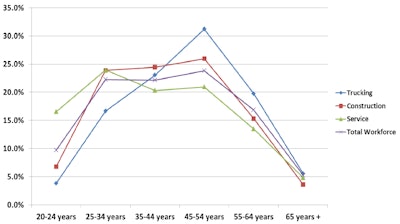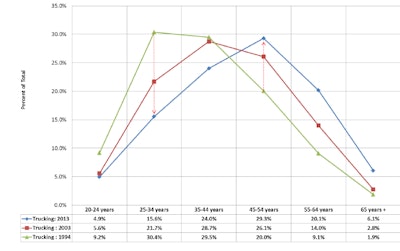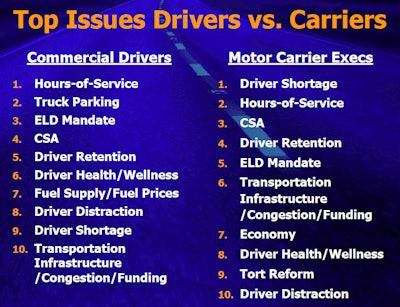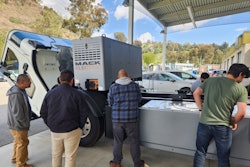 Chart from ATRI
Chart from ATRI
More than half of truck operators in the U.S. are 45 or older, according to data presented last week by the American Transportation Research Institute, and that could worsen current systemic issues faced by carriers now and worsen an already problematic driver recruiting and retention problem, ATRI says.
In a conference call hosted Friday by Stifel Capital Markets, ATRI President Rebecca Brewster outlined the shifting age demographics among truck operators.
The number of drivers in the 25-34 age group “have decreased significantly over time,” Brewster says, as the chart below notes:

Brewster says the industry’s current “greatest generation” of truck operators started their careers over 20 years ago. But those drivers will be retiring within the next decade or so, and carriers will be faced with trying to replace them.
However, the industry’s shift to older employees is a more recent trend than previously thought, Brewster said.
“Post-2003, and it might be related to the Great Recession, when a lot of people left and simply didn’t return,” she said, saying former drivers sought employment in other industries.
 Brewster referenced this slide from a November ATRI report showing some similarities between concerns of drivers and concerns of fleet executives.
Brewster referenced this slide from a November ATRI report showing some similarities between concerns of drivers and concerns of fleet executives.Brewster reinforced ideas that have been discussed among carrier advocacy groups to tackle the issues, such as the “graduated CDL” idea to bridge the eligibility gap between high-school graduation and age 21, likewise a push for more vocational education in high school about careers in transportation, including truck operation.
But she also noted data sources that could help carrier operations teams better plan routes to help improve the driver’s experience on the road, avoiding the pitfalls on long-distance hauling. One such tool is ATRI’s report on the top freight bottlenecks in the nation. Dive into that study and you’ll find ideal times for traversing those bottlenecks, when the average speed has historically been highest.
Often, however, that’s the midnight-5 a.m. period, which happens also to be the one off-limits to any driver taking a restart prior to the Congressionally-forced change to the Federal Motor Carrier Safety Administration’s 2013-implemented restart restrictions, widely considered to have compounded daytime congestion — and nighttime and other parking — issues.
The battle with the Federal Motor Carrier Safety Administration over the hours of service’s restart restrictions saw a certain amount of concurrence between drivers’ and carriers’ concerns, and illustrated how important hours flexibility had become for drivers navigating an increasingly congested, and dangeous, highway system. It will be difficult, she said, to keep drivers in trucking if “the drivers are forced … to drive during periods of increased risk” due to the nature of the hours of service regulations.














